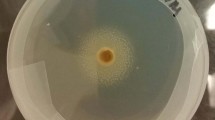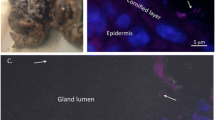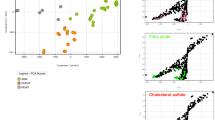Abstract
Sebocytes are specialized epithelial cells that rupture to secrete sebaceous lipids (sebum) across the mammalian integument. Sebum protects the integument from UV radiation, and maintains host microbial communities among other functions. Native glandular sebum is composed primarily of triacylglycerides (TAG) and wax esters (WE). Upon secretion (mature sebum), these lipids combine with minor cellular membrane components comprising total surface lipids. TAG and WE are further cleaved to smaller molecules through oxidation or host enzymatic digestion, resulting in a complex mixture of glycerolipids (e.g., TAG), sterols, unesterified fatty acids (FFA), WE, cholesteryl esters, and squalene comprising surface lipid. We are interested if fatty acid methyl ester (FAME) profiling of bat surface lipid could predict species specificity to the cutaneous fungal disease, white nose syndrome (WNS). We collected sebaceous secretions from 13 bat spp. using Sebutape® and converted them to FAME with an acid catalyzed transesterification. We found that Sebutape® adhesive patches removed ~6× more total lipid than Sebutape® indicator strips. Juvenile eastern red bats (Lasiurus borealis) had significantly higher 18:1 than adults, but 14:0, 16:1, and 20:0 were higher in adults. FAME profiles among several bat species were similar. We concluded that bat surface lipid FAME profiling does not provide a robust model predicting species susceptibility to WNS. However, these results provide baseline data that can be used for lipid roles in future ecological studies, such as life history, diet, or migration.




Similar content being viewed by others
Abbreviations
- C:
-
Cholesterol
- CE:
-
Cholesteryl ester
- C:M:
-
Chloroform/methanol
- DAG:
-
Diacylglyceride(s)
- FA:
-
Fatty acid(s)
- FAME:
-
Fatty acid methyl ester(s)
- FFA:
-
Unesterified fatty acid(s)
- GC:
-
Gas chromatography
- IT:
-
Ion trap
- LC:
-
Liquid chromatography
- LOQ:
-
Limit of quantification
- MAG:
-
Monoacylglyceride(s)
- MS:
-
Mass spectrometry
- PL:
-
Phospholipid(s)
- PUFA:
-
Polyunsaturated fatty acid(s)
- SL:
-
Sphingolipid(s)
- TAG:
-
Triacylglyceride(s)
- WE:
-
Wax ester(s)
- WNS:
-
White nose syndrome
References
Blehert D, Hicks AC, Behr M, Meteyer CU, Berlowski-Zier BM, Buckles EL, Coleman JTH, Darling SR, Gargas A, Niver R, Okoniewski JC, Rudd RJ, Stone WB (2009) Bat white-nose syndrome: an emerging fungal pathogen? Science 323:227
Gargas A, Trest MT, Christensen M, Volk TJ, Blehert DS (2009) Geomyces destructans sp. nov. associated with bat white-nose syndrome. Mycotaxon 108:147–154
Lorch JM, Meteyer CU, Behr MJ, Boyles JG, Cryan PM, Hicks AC, Ballmann AE, Coleman JTH, Redell DN, Reeder DM, Blehert DS (2011) Experimental infection of bats with Geomyces destructans causes white-nose syndrome. Nature 480:376–378
Minnis AM, Lindner DL (2013) Phylogenetic evaluation of Geomyces and allies reveals no close relatives of Pseudogymnoascus destructans, comb. nov., in bat hibernacula of eastern North America. Fungal Biol 117:638–649
Boyles JG, Cryan PM, McCracken GF, Kunz TH (2011) The economic importance of bats in agriculture. Science 332:41–42
Kunz TH, Braun de Torrez E, Bauer D, Lobova T, Fleming TH (2011) Ecosystem services provided by bats. Ann NY Acad Sci 1223:1–38
Frick WF, Pollock JF, Hicks AC, Langwig KE, Reynolds DS, Turner GG, Butchkoski CM, Kunz TH (2010) An emerging disease causes regional population collapse of a common North American bat species. Science 329:679–682
Meteyer CU, Buckles EL, Blehert DS, Hicks AC, Green DE, Shearn-Bochsler V, Thomas NJ, Gargas A, Behr MJ (2009) Histopathologic criteria to confirm white-nose syndrome in bats. J Vet Diagn Invest 21:411–414
Cryan PM, Meteyer CU, Boyles JG, Blehert D (2010) Wing pathology of white-nose syndrome in bats suggests life-threatening disruption of physiology. BioMed Central 8:135–143
Cryan PM, Meteyer CU, Blehert DS, Lorch JM, Reeder DM, Turner PP, Webb J, Behr M, Verant M, Russe RE, Castle KT (2013) Electrolyte depletion in white-nose syndrome bats. J Wildlife Dis 49:398–402
Willis CKR, Menzies AK, Boyles JG, Wojciechowski MS (2011) Evaporative water loss is a plausible explanation for mortality of bats from white-nose syndrome. Integr Comp Bio 51:364–373
Warnecke L, Turner JM, Bollinger TK, Lorch JM, Misra V, Cryan PM, Wibbelt G, Blehert DS, Willis CKR (2012) Inoculation of bats with European Geomyces destructans supports the novel pathogen hypothesis for the origin of white-nose syndrome. PNAS 109:6999–7003
Langwig KE, Frick WF, Bried JT, Hicks AC, Kunz TH, Kilpatrick A (2012) Sociality, density-dependence and microclimates determine the persistence of populations suffering from a novel fungal disease, white-nose syndrome. Ecol Lett 15:1050–1057
Moore MS, Reichard JD, Murtha TD, Zahedi B, Fallier RM, Kunz TH (2011) Specific alterations in complement protein activity of little brown myotis (Myotis lucifugus) hibernating in white-nose syndrome affected sites. PLoS One 6:e27430
Reeder DM, Frank CL, Turner GG, Meteyer CU, Kurta A, Britzke ER, Vodzak ME, Darling SR, Stihler CW, Hicks AC, Jacob R, Grieneisen LE, Brownlee SA, Muller LK, Blehert DS (2012) Frequent arousal from hibernation linked to severity of infection and mortality in bats with white-nose syndrome. PLoS One 7:1–10
Perry RW (2013) A review of factors affecting cave climates for hibernating bats in temperate North America. Env Review 21:28–39
Pannkuk EL, Gilmore DF, Savary BJ, Risch TS (2012) Triacylglyceride (TAG) profiles of integumentary lipids isolated from three bat species determined by matrix-assisted laser desorption–ionization time-of-flight mass spectrometry (MALDI–TOF MS). Can J Zool 90:1117–1127
Pannkuk EL, Gilmore DF, Fuller N, Savary BJ, Risch TS (2013) Sebaceous lipid profiling of bat integumentary tissues: quantitative analysis of free fatty acids, monoacylglycerides, squalene, and sterols. Chem Biodiver 10:2122–2132
Desbois AP, Smith VJ (2010) Antibacterial free fatty acids: activities, mechanisms of action and biotechnological potential. Appl Microbiol Biotechnol 85:1629–1642
Bergsson G, Hilmarsson H, Thormar H (2011) Antibacterial, antiviral and antifungal activities of lipids. In: Thormar H (ed) Lipids and essential oils as antimicrobial agents. Wiley, West Sussex, pp 47–80
Fleck CB, Schöbel F, Brock M (2011) Nutrient acquisition by pathogenic fungi: nutrient availability, pathway regulation, and differences in substrate utilization. Intern J Medical Microbiol 301:400–407
Michael-Jubeli R, Bleton J, Baillet-Guffroy A (2011) High-temperature gas chromatography-mass spectrometry for skin surface lipids profiling. J Lipid Res 52:143–151
Muñoz-Garcia A, Ro J, Reichard JD, Kunz TH, Williams JB (2012) Cutaneous water loss and lipids of the stratum corneum in two syntopic species of bats. Comp Biochem Physiol A 161:208–215
Pagnoni A, Kligman AM, Gammal EL, Popp C, Stoudemayer T (1994) An improved procedure for quantitative analysis of sebum production using Sebutape®. J Soc Cosmet Chem 45:221–225
Camera E, Ludovici M, Galante M, Sinagra JL, Picardo M (2010) Comprehensive analysis of the major lipid classes in sebum by rapid resolution high-performance liquid chromatography and electrospray mass spectrometry. J Lipid Research 51:3377–3388
Nordstrom KM, Schmus HG, McGinley KJ, Leyden JJ (1986) Measurement of sebum output using a lipid absorbent tape. J Invest Dermatol 87:260–263
Law S, Wertz PW, Swartzendruber DC, Squier CA (1995) Regional variation in content, composition, and organization of porcine epithelial barrier lipids revealed by thin layer chromatography and transmission electron microscopy. Arch Oral Biol 40:1085–1091
Pannkuk EL, Risch TS, Savary BJ (2013) Profiling the triacylglyceride contents in bat integumentary lipids by preparative thin layer chromatography and MALDI-TOF mass spectrometry. J Vis Exp 79:e50757
Pochi PE, Strauss JS, Downing DT (1979) Age-related changes in sebaceous gland activity. J Investigate Dermat 73:108–111
Pappas A, Fantasia J, Chen T (2013) Age and ethnic variations in sebaceous lipids. Dermato-Endocrin 5:319–324
Jacobsen E, Billings JK, Frantz RA, Kinney CK, Stewart ME, Downing DT (1985) Age-related changes in sebaceous wax ester secretion rates in men and women. J Invest Dermat 85:483–485
Yamamoto A, Serizawa S, Ito M, Sato Y (1987) Effect of aging on sebaceous gland activity and on the fatty acid composition of wax esters. Soc Invest Dermatol 89:507–512
Zelle L (1999) Fatty acid patterns of phospholipids and lipopolysaccharides in the characterisation of microbial communities in soil: a review. Bio Fer Soil 29:111–129
Takigawa H, Nakagawa H, Kuzukawa M, Mori H, Imokawa G (2005) Deficient production of hexadecenoic acid in the skin is associated in part with the vulnerability of atopic dermatitis patients to colonisation by Staphylococcus aureus. Dermat 211:240–248
Cortese TA, Nicoll PA (1970) In vivo observations of skin appendages in the bat wing. J Invest Dermatol 54:1–11
Nassar JM, Salazar MV, Quintero A, Stoner KE, Gómez M, Cabrera A, Jaffe K (2008) Seasonal sebaceous patch in the nectar-feeding bats Leptonycteris curasoae and L. yerbabuenae (Phyllostomidae: Glossophaginae): Phenological, histological, and preliminary chemical characterization. Zoology 111:363–376
Pannkuk EL, McGuire LP, Gilmore DF, Savary BJ, Risch TS (2014) Glycerophospholipid analysis of Eastern red bat (Lasiurus borealis) hair by electrospray ionization tandem mass spectrometry. J Chem Ecol 40:227–235
Pannkuk EL, Blair HB, Fischer AE, Gerdes CL, Gilmore DF, Savary BJ, Risch TS (2014) Triacylglyceride composition and fatty acyl saturation profile of a psychrophilic and psychrotolerant fungal species grown at different temperatures. Fungal Biol 118:792–799
Acknowledgments
This project was funded by the Arkansas State Wildlife Grant, the National Speleological Society, the graduate program of environmental science at Arkansas State University (ASU), Bat Conservation International, and the Center for North American Bat Research and Conservation at Indiana State University. Laboratory assistance was provided by K. Arter and H. Southe (Arkansas State University). Samples were collected by C. Gerdes (Missouri State University), T. Divoll (Biodiversity Research Institute), and P. Jordan (Arkansas State University). We thank the ecotoxicology research facility (Arkansas State University; J. Bouldin and T. Woodruff) for assistance with GC/MS (NSF Grant #1040466).
Author information
Authors and Affiliations
Corresponding author
About this article
Cite this article
Pannkuk, E.L., Fuller, N.W., Moore, P.R. et al. Fatty Acid Methyl Ester Profiles of Bat Wing Surface Lipids. Lipids 49, 1143–1150 (2014). https://doi.org/10.1007/s11745-014-3951-2
Received:
Accepted:
Published:
Issue Date:
DOI: https://doi.org/10.1007/s11745-014-3951-2




